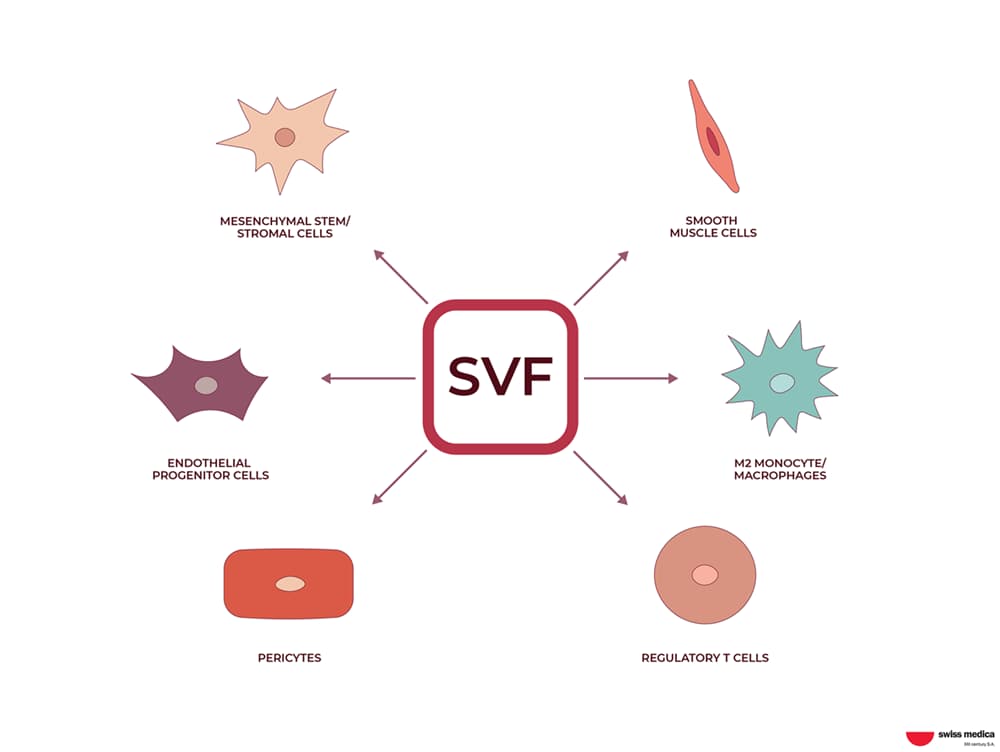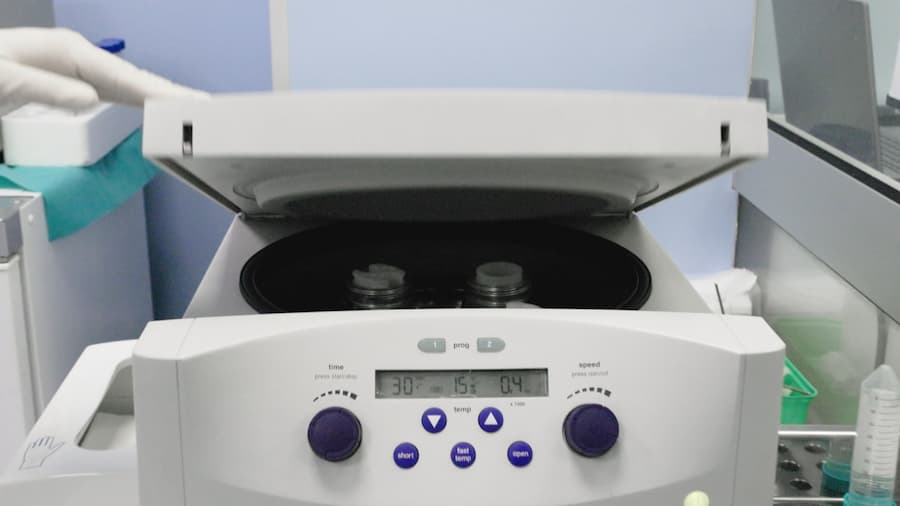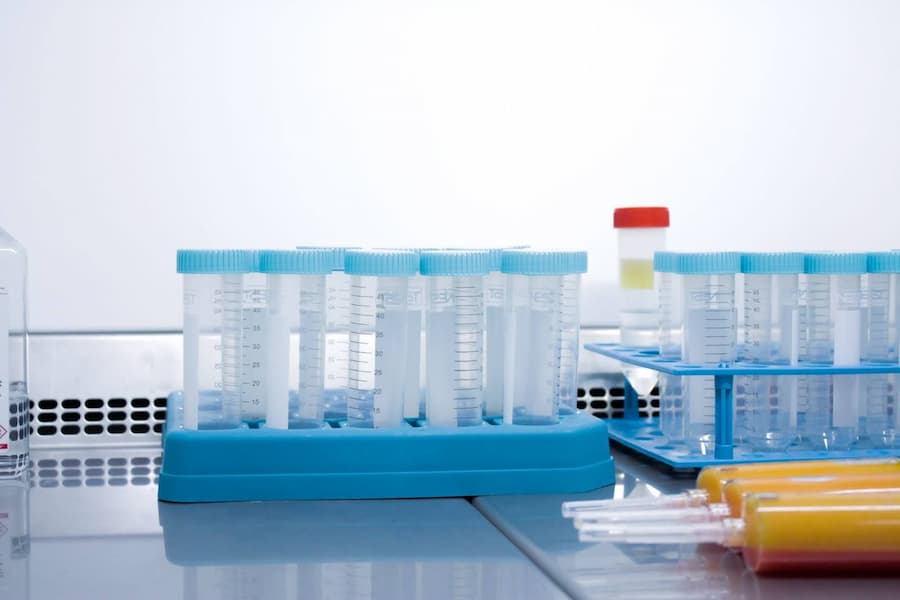Stromal-vascular fraction (SVF) therapy uses a mix of cells from adipose tissue, which is the patient’s fat tissue. When purified SVF cells are delivered through a minimally invasive procedure, they help with recovering, reducing inflammation, and controlling the immune system. In this article, we’ll provide a detailed answer to the question, “What is stromal-vascular fraction?” and explore the benefits of this therapy.

What other types of cells are involved in stem cell therapy? Discover in our article.
Explore nowWhat Makes SVF Stem Cell Therapy So Beneficial
What is stromal-vascular fraction’s main advantage in regenerative medicine? Let’s dive into some of the key benefits.
Easy Access and Minimal Pain
SVF is derived from fat tissue, which is readily available and can be accessed through a minor liposuction procedure with minimal pain and no downtime required.
SVF Contains a High Concentration of Stem Cells
After undergoing specific procedures (explained later), we obtain SVF, which is rich in:
- Mesenchymal stromal cells (MSCs)
- Monocytes / M2 macrophages
- Endothelial cells
- T-regulatory cells
- Smooth muscle cells
This combination enhances the viability and integration of the transplanted fat and promotes tissue repair and rejuvenation.
Not familiar with these cell types?
Explore our detailed articles on each one:
MSCs: Learn more here.
M2 Macrophages: Discover more here.
T-Regulatory Cells: Find out here.
Improved Fat Graft Survival
The improved survival rate of SVF-enriched fat grafts means patients can achieve the desired results with fewer treatment sessions.
When Do We Use SVF Stem Cell Therapy
We often include stromal-vascular fraction therapy in programs to treat the following conditions:
| Condition/disease | How SVF cell therapy helps |
| Diabetes | SVF therapy may help regenerate pancreatic cells and improve insulin sensitivity. |
| Arthritis | SVF may help repair joint tissues and decrease pain, which reduces the need for NSAID usage and improves the quality of life. |
| Retinal diseases | SVF may help prevent retinal degeneration and strengthen retinal function, which contributes to vision improvement. |
| Lyme disease | SVF cell therapy may modulate the immune system and lower inflammation associated with the disease. |
| Other | Researchers are investigating the potential of SVF therapy in managing various conditions, including pulmonary, autoimmune, and cardiovascular diseases. |
Get a free online consultation
Schedule an online consultation with one of our medical advisors to explore how SVF cell therapy could benefit you. They will thoroughly assess your situation and recommend the best treatment plan tailored to your needs.

Medical Advisor, Swiss Medica doctor
SVF Collection and Preparation
At Swiss Medica, we thoroughly prepare SVF in our own laboratory to avoid contamination and help our patients achieve more consistent results. The preparation process for SVF therapy consists of three steps.
Step 1. Cell collection
| Source of SVF | Fat tissue is usually collected from the patient’s front abdominal area. We only use cells from the patient’s own body in SVF therapies. |
| The volume of SVF cells taken | Depending on the subcutaneous fat availability, we usually collect about 50 milliliters of fat. |
| Method for collection | The doctor uses a long aspiration needle to make a small incision around the belly button or the flanks of the abdomen and gently removes the patient’s fat tissue. The procedure is performed under general anesthesia. |
At the patient’s request, we may keep a part of the SVF cells and use them during their next visit, without the need for a repeated cell collection procedure.
Step 2. Cell preparation: Purification and isolation
The obtained solution, known as lipoaspirate, is processed using emulsification and centrifugation procedures. This way, we can destroy the extracellular matrix and isolate SVF cells from free fat and other unwanted components. As a result, we obtain the highest possible quality of SVF.

Step 3. Administration
Usually, cell therapies require laboratory cultivation in sterile conditions to receive a cell product. In contrast, SVF cells can be used immediately after purification and within 2–3 hours of lipoaspiration without the need for cultivation. This decreases the risk of contamination and potential changes to the cells’ properties and helps keep native characteristics and functionality.

Check out our detailed article to explore the complete stem cell production process.
Read nowHow Do We Deliver SVF
There are two primary methods for delivering the stromal-vascular fraction into the patient’s body.
Intravenous Administration
This way, the doctor provides stromal-vascular fraction therapy by slowly injecting the cells through a vein using an IV line with a needle. This minimally invasive procedure ensures quick and better absorption as SVF bypasses the digestive system.
Want to know more about how the intravenous method is performed?
Discover the details here.
Local Administration
This minimally invasive procedure implies that SVF cells are applied directly to a specific area of the body. Possible methods include retrobulbar (behind the eyeball), para-articular (near the joint), and intra-articular (into a joint) injections.
Interested in the local administration process?
Explore the specifics here.
Usually, the procedure lasts approximately 4 hours, from the beginning of the procedure to the moment when the patient gets his cell procedure.
The processing of SVF cells takes up to 90 minutes. You can be sure that the medical staff will monitor your safety during the procedure.
Dosages
For IV infusions in adults, the typical dose ranges from 150 to 200 million cells. The exact dosage depends on the patient’s condition, the symptoms, and other individual factors, such as age and weight.
Program Duration
The minimum length of an SVF stem cell therapy program is generally 5 days. During this time, the patient undergoes examination before the procedure and observation after the treatment to exclude complications. We also carry out additional procedures to increase the effectiveness of cell treatment (IMR, physiotherapy, procedures with exosomes).
Interested in learning about every step of the stem cell therapy process?
Explore the complete details in our article.
Contraindications
Usually, cell-based therapies are generally well-tolerated and cause no serious side effects. The contraindications for using the stromal-vascular fraction (SVF) are similar to those for mesenchymal stromal cells (MSCs) and include:
- Active oncology,
- Acute infections,
- Prior negative experiences with such treatment,
- Personal characteristics, such as age, body weight,
- Mental disorders.
Also, some conditions may carry risks during the collection process of the SVF:
- Hypocoagulation: reduced blood clotting ability,
- The use of anticoagulant therapy: medications that prevent blood clotting.
The doctors carefully assess each case to ensure the safety and efficacy for each patient.
Treatment Results
The treatment results depend on the severity, duration of the condition and the individual characteristics of the patient. For most conditions, patients experience full benefits of the therapy within 1 to 3 months after treatment. These positive effects.
The effects of SVF stem cell therapy typically last up to six months and may diminish within a year. However, in rare cases, positive results can persist for several years.
Contact us
To discuss how SVF cell therapy could benefit you and what results to expect, schedule a no-obligation consultation with our medical advisors.

Medical Advisor, Swiss Medica doctor
Ready to Explore More?
Discover the full potential of stem cells and dive into additional articles.
List of References
Czerwiec K, Zawrzykraj M, Deptuła M, Skoniecka A, Tymińska A, Zieliński J, Kosiński A, Pikuła M. Adipose-Derived Mesenchymal Stromal Cells in Basic Research and Clinical Applications. Int J Mol Sci. 2023 Feb 15;24(4):3888. doi: 10.3390/ijms24043888. PMID: 36835295; PMCID: PMC9962639.
Wenqing JIANG, Yunjun LIAO, Feng LU, Fat Grafting for Rejuvenation and Regeneration with Stromal Vascular Fraction Gel, Chinese Journal of Plastic and Reconstructive Surgery, Volume 2, Issue 3, 2020, Pages 181-186, ISSN 2096-6911, https://doi.org/10.1016/S2096-6911(21)00033-9.
Yating Yin, Jianhua Li, Qiang Li, Aijun Zhang, Peisheng Jin, Autologous fat graft assisted by stromal vascular fraction improves facial skin quality: A randomized controlled trial, Journal of Plastic, Reconstructive & Aesthetic Surgery, Volume 73, Issue 6, 2020, Pages 1166-1173,ISSN 1748-6815, https://doi.org/10.1016/j.bjps.2019.11.010.
Remelia, M., Novriandina, S., Karina, Panjaitan, A. O., Andriana, J., Sitohang, J., Batubara, F., Wiyanto, M., & Sitompul, Y. R. (2024). Effect of autologous stromal vascular fraction (SVF) for diabetes mellitus type-2. Majalah Kedokteran UKI, 38(1), 3-7. https://doi.org/10.33541/mk.v38i1.4188
Goncharov, E.N.; Koval, O.A.; Igorevich, E.I.; Encarnacion Ramirez, M.D.J.; Nurmukhametov, R.; Valentinovich, K.K.; Montemurro, N. Analyzing the Clinical Potential of Stromal Vascular Fraction: A Comprehensive Literature Review. Medicina 2024, 60, 221. https://doi.org/10.3390/medicina60020221